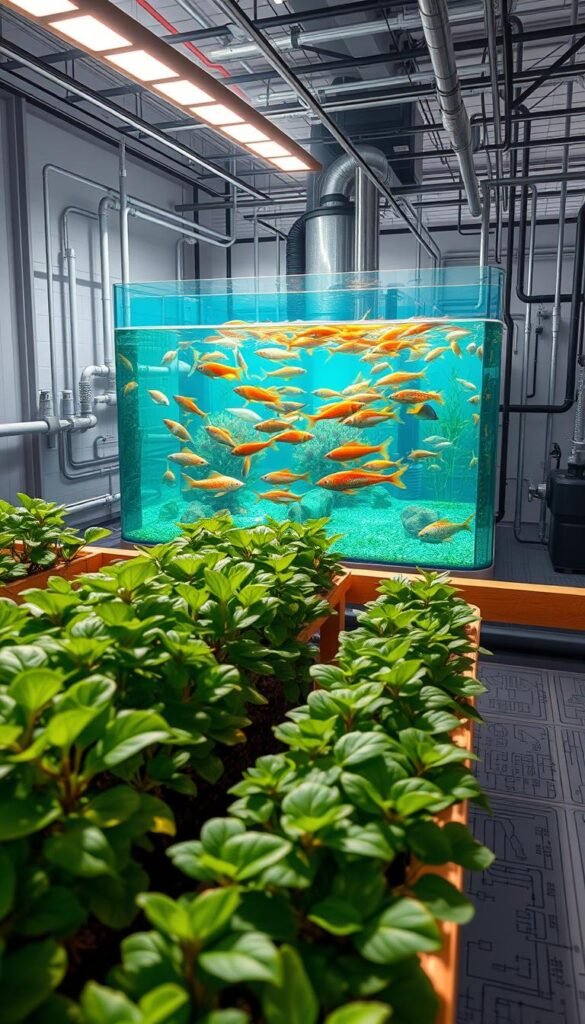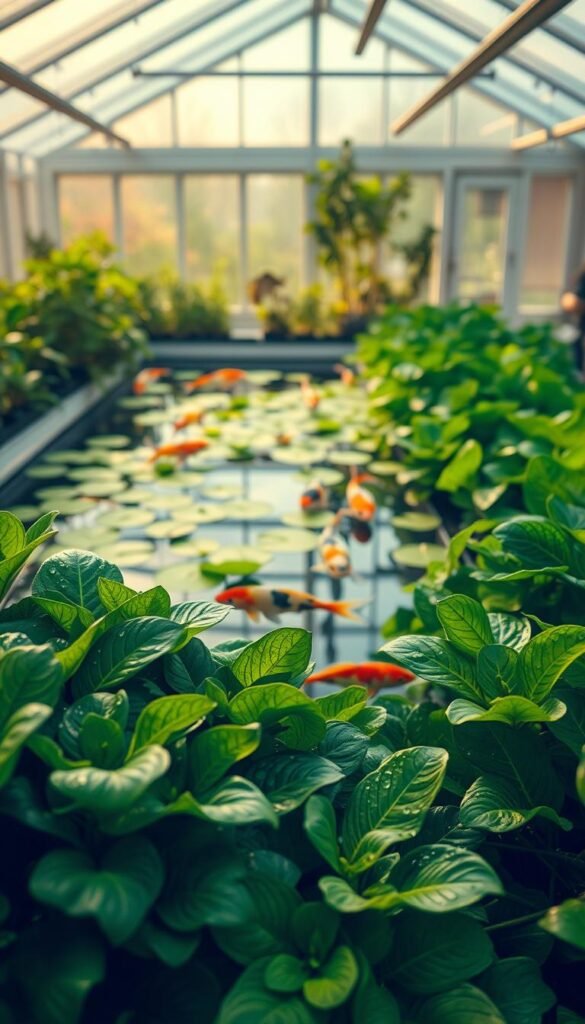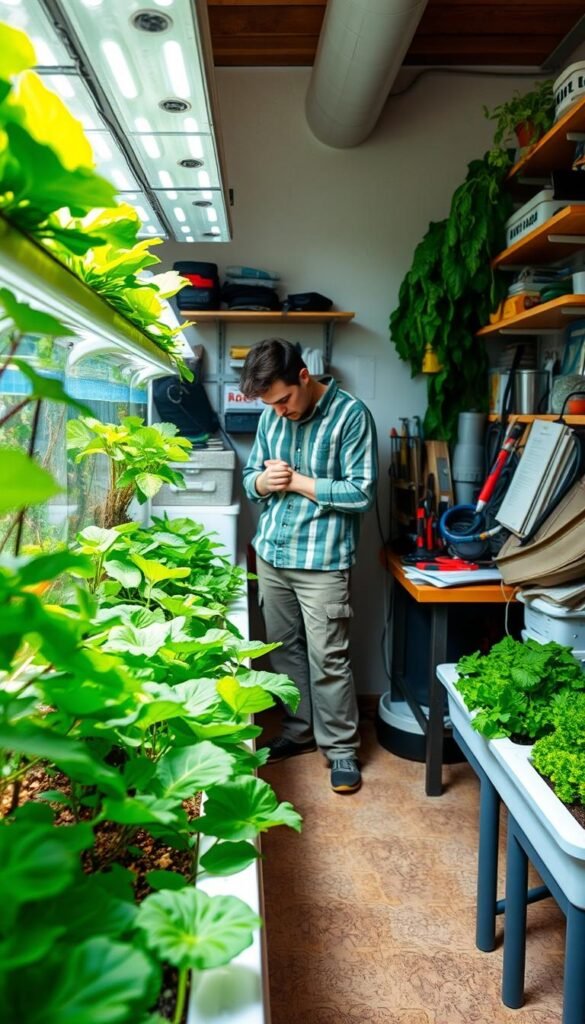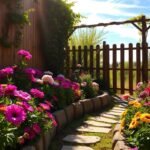Imagine a self-sustaining ecosystem where plants and aquatic life thrive together. This is the heart of aquaponics, a method that merges fish farming (aquaculture) with soil-free plant cultivation (hydroponics). By harnessing natural cycles, you create a loop where fish waste nourishes your greens, and the plants purify the water. It’s a win-win for both.
Whether you’re new to eco-friendly practices or seeking a fresh approach, this guide simplifies everything. You’ll learn how to set up a cost-effective system, choose the right tools, and maintain balance effortlessly. We’ll even break down the science, like how bacteria convert ammonia into plant-friendly nutrients.
Why try this method? It uses 90% less water than traditional gardening and skips synthetic fertilizers. Plus, you’ll harvest fresh veggies and protein-rich fish year-round. Our step-by-step tips ensure success, even if you’ve never kept a houseplant alive.
Key Takeaways
- Aquaponics combines fish farming and hydroponics for a sustainable setup.
- Natural processes like the nitrogen cycle keep the system balanced.
- It uses significantly less water than conventional gardening methods.
- You can grow edible plants and fish simultaneously in one space.
- Beginner-friendly systems require minimal maintenance once established.
Introduction & Benefits of Aquaponic Gardening
Modern food production faces two challenges: shrinking space and rising environmental costs. Here’s where closed-loop systems shine. By pairing fish tanks with plant beds, you create a living machine that grows food while recycling resources endlessly.
Why Aquaponics is a Game Changer
Fish and greens aren’t just neighbors—they’re teammates. Fish release nutrients through their waste, which bacteria convert into plant food. In return, vegetation filters the water, keeping it safe for aquatic life. This teamwork eliminates chemical fertilizers and slashes water use by up to 90% compared to soil gardening.
Urban dwellers love it. A compact setup fits on balconies or patios, producing herbs, leafy greens, and even tilapia. No yard? No problem. Vertical designs maximize yields in tight spots.
Sustainable and Space-Saving Advantages
Traditional farms need acres. Aquaponics thrives in 10 square feet. Systems like deep water culture let roots float directly in nutrient-rich water, skipping soil entirely. Media-based setups use clay pellets instead, offering flexibility for different crops.
| Feature | Traditional Gardening | Aquaponic System |
|---|---|---|
| Water Usage | High | Low (90% less) |
| Space Required | Large plots | Compact/vertical |
| Fertilizers | Synthetic needed | Natural fish waste |
Startup costs are modest. Repurpose old tanks or barrels for DIY builds. Once running, daily care takes minutes—just feed the fish and monitor pH levels. It’s farming simplified for busy lives.
Exploring Aquaponic Gardening 101: Grow Plants and Fish in Harmony
Transforming your home into a productive ecosystem is easier than you think. At its core, this method thrives on the partnership between aquatic life and greenery. You’ll nurture both in a closed-loop setup where each supports the other’s growth. It’s nature’s teamwork, simplified for your daily life.

Most systems feature three main parts: a fish tank, grow beds, and a water pump. The design adapts to your available area—vertical stacks work for tight corners, while tabletop units fit kitchens. Even a sunny balcony can host a thriving setup with leafy greens like basil or mint.
New to this? Common questions include how much time it takes (minutes per day) and which species thrive together. This guide breaks it down step by step. You’ll learn:
| Space Type | Recommended Design | Best Plants |
|---|---|---|
| Small balconies | Vertical NFT systems | Herbs, lettuce |
| Patios | Media-based beds | Tomatoes, peppers |
| Indoor spaces | Compact hybrid setups | Microgreens, kale |
Upcoming sections dive into system components, fish selection, and maintenance routines. Whether you’re optimizing a studio apartment or backyard, you’ll find tailored solutions here. Let’s turn your space into a flourishing, edible oasis.
Understanding Aquaponics: The Process and Key Components
Nature recycles everything—your aquaponics system does too. At its core, this method relies on three partners: fish, plants, and invisible helpers. Together, they turn waste into nourishment through precise biological teamwork.
The Nitrogen Cycle Explained
Here’s how it works: fish produce ammonia-rich waste. Beneficial bacteria then convert this into nitrites, and finally nitrates—a plant-friendly fertilizer. This transformation happens in three steps:
- Ammonia from the fish tank enters the grow beds
- Nitrosomonas bacteria change it to nitrites
- Nitrobacter species turn nitrites into nitrates
Your greens absorb these nutrients, purifying the water that cycles back to the fish. This loop repeats every few minutes in active systems, maintaining balance.
Role of Beneficial Bacteria and Biofilters
Biofilters house these microbial heroes. Materials like clay pellets (grow media) or sponges provide surface area for bacterial colonies. Without them, toxins would overwhelm your fish.
Key components work together:
- Fish tank: Home for aquatic life
- Pump: Moves water through the system
- Grow beds: Where plants and bacteria collaborate
Monitoring water quality is non-negotiable. Test pH (6.8-7.2 ideal) and ammonia weekly. Systems using nutrient film technique need extra attention to flow rates.
Want to master the science? Our guide on how these systems function breaks it down further. Once you grasp these basics, you’ll troubleshoot like a pro.
Designing Your Aquaponics System
Your setup’s success starts with smart design choices. The right layout maximizes space, boosts efficiency, and keeps your aquatic and plant partners thriving. Let’s explore how to match system types to your environment and goals.

Choosing the Right System Design for Your Space
Measure your available area first. Small spaces shine with vertical setups or nutrient film channels. Larger areas? Consider media beds or hybrid designs. For example, a 4’x4′ balcony could host a stacked unit growing herbs and leafy greens.
Overview of CHOP and Other Layouts
The CHOP system (Constant Height One Pump) simplifies water flow. It uses a single pump to cycle water between the fish tank and grow beds. Benefits include lower energy costs and stable oxygen levels. Compare it to other designs:
| Design | Best For | Maintenance Level |
|---|---|---|
| CHOP | Beginners & small spaces | Low |
| Media Beds | Root vegetables | Moderate |
| NFT Channels | Leafy greens | High |
Grow beds filled with clay pellets support robust plant growth while housing helpful bacteria. Pair them with tilapia or goldfish—their waste fuels the system. Feed fish high-quality fish food to ensure nutrient-rich water flows to your plants.
Balancing components is key. Too many plants? Fish might starve. Too few? Water quality drops. Test flow rates weekly and adjust pump timers as needed. With thoughtful design, you’ll create a self-regulating ecosystem that thrives with minimal input.
Choosing the Right Fish and Plants
Your system’s success depends on pairing aquatic life with greenery that work together seamlessly. Like matching puzzle pieces, some species thrive better than others in closed-loop environments. Let’s explore smart combinations that keep both parties happy and productive.
Top Fish Options for Beginners
Hardy species handle water fluctuations best. Tilapia tops the list—they grow fast and tolerate varied temperatures. Goldfish are another low-maintenance pick, though they need cooler water. For larger setups, channel catfish adapt well to media-based systems.
| Species | Temp Range | Diet | Best For |
|---|---|---|---|
| Tilapia | 75-85°F | Omnivorous | Warm climates |
| Goldfish | 65-75°F | Flakes/pellets | Small systems |
| Catfish | 70-80°F | Protein-rich | Spacious tanks |
Plant Selection for Optimal Growth
Plants need different nutrient levels. Leafy greens like lettuce and kale excel because they absorb nitrates quickly. Herbs such as basil also flourish, especially in floating raft designs. Avoid plants requiring acidic soil—they clash with fish-friendly pH levels.
Feed fish high-quality pellets twice daily, but avoid overfeeding. Excess food clouds water and stresses aquatic life. A balanced diet ensures nutrients plants require flow consistently through the system.
| Plant Type | Nutrient Needs | System Match |
|---|---|---|
| Lettuce | Low | NFT channels |
| Basil | Medium | Media beds |
| Kale | High | Deep water |
Diving Deeper into Aquaponic System Types
Which setup works best for your goals? Three main designs dominate closed-loop ecosystems, each with unique strengths. Let’s explore how media beds, deep water setups, and nutrient channels create harmony between aquatic life and vegetation.

Media-Based Systems: Flexible Foundations
Clay pellets or gravel fill these grow beds, offering dual benefits. They anchor plant roots while housing beneficial bacteria. This design handles heavy crops like peppers well but requires periodic cleaning to prevent clogs.
Water-Centric Methods: Simplicity First
Deep water culture floats plants on rafts, letting roots soak directly in nutrient-rich water. Nutrient film technique uses shallow streams flowing through sloped channels. Both excel with leafy greens but need precise water flow control.
| System Type | Space Needed | Maintenance | Best Plants |
|---|---|---|---|
| Media Beds | Moderate | Medium | Fruiting plants |
| Deep Water | Large | Low | Lettuce, herbs |
| Film Technique | Compact | High | Spinach, kale |
When building your system, consider these factors:
- Root space: Media beds support larger plant roots
- Oxygen levels: Film technique needs air pumps
- Water depth: Deep systems require sturdy rafts
Troubleshooting tip: If algae appears, reduce light exposure. For slow growth, check pump flow rates. A stable environment for growth starts with matching your space and crop choices to the right design.
Ready to build a system? Start small—a 50-gallon tank paired with a media bed makes an excellent beginner project. Test water pH weekly and adjust fish numbers as plants mature.
Step-by-Step Setup Guide
Ready to build your own thriving ecosystem? Let’s break down the process into manageable steps. Proper assembly ensures your starting system runs smoothly from day one. Focus on precision here—rushed setups often lead to leaks or stressed aquatic life.
Setting Up Your Fish Tank and Plumbing
Choose a level, shaded spot—direct sunlight causes algae blooms. Position your tank first, ensuring it’s sturdy enough to hold water and fish. Connect PVC pipes to the pump, routing them to the grow bed. Use sump tanks if your design includes them—they stabilize water flow during power outages.
Test all connections with water before adding fish. Fix leaks immediately using aquarium-safe sealant. Pro tip: Install a timer for automated flooding cycles. This prevents root rot and keeps oxygen levels steady.
Preparing and Cycling the Grow Bed
Fill the bed with rinsed clay pellets or gravel. These media house beneficial bacteria crucial for converting waste. Add dechlorinated water to the system, then let it circulate for 48 hours. This “wet run” reveals any adjustments needed.
Introduce fish gradually—start with just a few to avoid overwhelming the biofilter. Monitor ammonia spikes daily during the first week. If levels rise too fast, perform partial water changes to protect your aquatic partners.
Patience pays off. Full cycling takes 4-6 weeks, but once established, your system becomes nearly self-sufficient. Remember: Rushing this phase can stress fish and stall plant growth.
Navigating Water Quality and Maintenance
Keeping your ecosystem thriving starts with crystal-clear water. Regular checks prevent small issues from becoming crises. Let’s explore how to maintain ideal conditions for both aquatic and plant partners.
Monitoring pH and Nutrient Levels
Test water weekly using strips or digital meters. Aim for a pH between 6.8-7.2—this keeps fish waste conversion efficient. High acidity? Add crushed coral. Alkalinity too low? Baking soda raises it gently.
Track these four parameters:
| Parameter | Ideal Range | Solution if Off |
|---|---|---|
| Ammonia | 0-0.5 ppm | Reduce feeding |
| Nitrites | 0 ppm | Add bacteria starter |
| Nitrates | 5-50 ppm | Add more plants |
Yellowing leaves often signal low nitrates. Foamy water? Excess protein from fish food may be the culprit. Adjust portions gradually—fish should finish meals in 5 minutes.
Routine System Maintenance Tips
Clean grow media every 3 months to prevent clogging. Use a colander to rinse clay pellets, preserving beneficial bacteria. Siphon fish tank debris weekly—this reduces ammonia spikes.
Follow this 10-minute daily routine:
- Check pump flow
- Remove dead plant matter
- Observe fish behavior
Monthly tasks include inspecting pipes for algae and testing water hardness. Replace 10-15% of water if nitrates exceed 100 ppm. Consistent care keeps your system humming smoothly for years.
Optimizing Fish Feeding and Health
Proper feeding habits are the cornerstone of a thriving aquatic ecosystem. When done right, your finned friends stay vibrant, and plants receive steady nutrients. But overdo it, and you’ll face murky water and stressed fish. Let’s strike the perfect balance.
Mastering the Art of Nutrition
Feed fish small portions 2-3 times daily—only what they finish in 5 minutes. Uneaten food decays, spiking ammonia levels. For most species, a daily amount equal to 1-2% of their body weight works best. Use floating pellets to monitor consumption easily.
Choose feeds wisely:
- Commercial pellets: Balanced nutrients, easy to measure
- Organic options: Black soldier fly larvae or duckweed boost protein naturally
| Feed Type | Pros | Cons |
|---|---|---|
| Commercial | Precise nutrition | Higher cost |
| Organic | Sustainable | Requires cultivation |
Spot trouble early. If fish gasp at the surface or refuse meals, test water quality immediately. High ammonia? Reduce feeding and change 20% of the tank water. Cloudiness often signals overfeeding—cut portions by half for 2 days.
Remember: A clean fish tank supports efficient nutrient cycling. Use a gravel vacuum weekly to remove debris. Pair consistent feeding with routine checks, and your system will hum with life.
Enhancing Plant Growth in Aquaponics
Bright light fuels your greens, but balance is everything. To thrive, your setup must mimic nature’s rhythms while adapting to indoor conditions. Three factors make or break success: illumination, climate control, and nutrient access.

Light, Temperature, and Nutrient Requirements
Plants need 6-8 hours of daily light. South-facing windows work for sun-loving varieties like tomatoes. In darker spaces, LED grow lights with 6500K color temperature mimic daylight efficiently. Avoid overheating—keep lights 12-18 inches above foliage.
| Light Source | Best For | Energy Use | Setup Cost |
|---|---|---|---|
| Natural sunlight | Outdoor/balcony setups | None | $0 |
| Full-spectrum LEDs | Leafy greens & herbs | Low | $50-$150 |
| Fluorescent tubes | Seedlings | Medium | $30-$80 |
Water temperature impacts both roots and fish. Keep it between 65-75°F for most plants. Floating thermometers help track changes. Cooler water slows plant growth, while warmth accelerates algae.
Test nitrate levels weekly. Ideal ranges:
- Leafy greens: 20-50 ppm
- Fruiting plants: 50-100 ppm
Space plants properly. Overcrowding blocks light and airflow. Rotate trays every few days so all sides receive equal exposure. Remember: healthy roots mean vibrant leaves. Check for white, odorless root systems monthly.
Planning Your Aquaponics Space and Layout
Smart spatial planning transforms cluttered corners into thriving ecosystems. Start by measuring your area’s length, width, and height. Use painter’s tape to outline where components will go—this visual guide prevents overcrowding. Leave 18-24 inches of walkway space for easy access during maintenance.
Strategic design prioritizes workflow. Place the fish tank near electrical outlets for pumps, and position grow beds where they’ll get 6-8 hours of sunlight daily. Vertical racks or wall-mounted shelves maximize tight space efficiently. For indoor setups, LED lights mounted above plants mimic natural cycles.
Three factors shape your layout:
- Ventilation: Fans prevent humidity buildup near walls
- Drainage: Slope floors slightly toward drains to avoid puddles
- Light exposure: Rotate mobile beds weekly for even growth
Test your plan with a simple checklist:
| Check | Ideal Standard | Tool Needed |
|---|---|---|
| Floor stability | Holds 8.3 lbs/gallon of water | Level |
| Electrical safety | GFCI outlets within 3 ft | Outlet tester |
| Accessibility | Elbow room around all components | Tape measure |
Remember: A well-planned design cuts daily chores in half. Adjust as your system evolves—modular setups let you expand without rebuilding from scratch. With thoughtful space allocation, even a studio apartment can yield fresh harvests effortlessly.
Troubleshooting Common Aquaponics Challenges
Even the best setups face hiccups now and then. Recognizing early warning signs keeps small issues from becoming major headaches. Let’s tackle the most frequent questions and restore your system’s harmony efficiently.

Managing Algae, Pests, and Water Quality Issues
Algae thrives in sunlight. Cover exposed water surfaces with dark lids or floating plants. If green slime appears, reduce light exposure to 6 hours daily. For pest invasions like aphids, introduce ladybugs—they’re natural predators that won’t harm your fish.
Cloudy water often signals excess fish waste. Test ammonia levels immediately. If above 0.5 ppm:
- Cut feeding by 30% for 3 days
- Add extra aeration with an air stone
- Increase plant density to absorb nutrients faster
In nutrient film technique systems, adjust flow rates to 1-2 liters per minute. This prevents root drying without oversaturating channels.
Tips to Restore System Balance
Daily checks take just 5 minutes but prevent disasters. Use this quick routine:
- Inspect fish for lethargy or rapid gill movement
- Scan plant leaves for discoloration
- Verify pump operation
| Issue | Quick Fix | When to Act |
|---|---|---|
| pH drop below 6.5 | Add crushed oyster shells | Within 24 hours |
| Nitrite spike | 25% water change | Immediately |
| Fish refusing food | Test for ammonia | Same day |
Still stuck? Contact local aquaponics groups for tailored advice. Sometimes a design tweak—like adding a swirl filter—solves persistent fish waste buildup. Stay observant, and your ecosystem will bounce back stronger.
Leveraging DIY Tips and Build Plans
Building your own setup doesn’t require fancy equipment—just smart planning. With basic tools and creativity, you can craft a functional ecosystem that supports plant roots and aquatic life efficiently. Let’s explore how to assemble a building system that adapts to your space and budget.
Essential Materials and Tools for Your System
Start with these core items:
- Plumbing supplies: PVC pipes, bulkhead fittings, and a reliable water pump
- Food-safe containers (IBC totes work well for tanks and grow beds)
- Clay pellets or gravel for stable root support
| Component | Purpose | Cost Range |
|---|---|---|
| Sump tank | Regulates water flow | $30-$80 |
| Air pump | Boosts oxygen levels | $25-$60 |
| Grow bed frame | Supports plant weight | $15-$50 |
Insights from Successful Build Plans
Experienced builders recommend these strategies:
- Use sump tanks to prevent pump burnout during power outages
- Slope plumbing lines slightly for consistent water flow
- Test all joints with water before adding fish
One gardener shared: “Double-checking pipe seals saved me from a flooded basement.” Allow room for adjustments—modular designs let you expand later. For a stable environment, secure grow beds with sturdy brackets and insulate pipes in cold climates.
Ready to customize? Swap PVC for flexible tubing in tight spaces, or repurpose old bathtubs as grow beds. Your system will evolve as you learn—that’s half the fun!
Conclusion
Embracing this method unlocks a world where your greens and aquatic partners flourish together. By merging fish tank ecosystems with plant beds, you create a self-cleaning loop that saves water and skips synthetic additives. It’s nature’s teamwork at its finest—fish nourish your crops, while plants return purified water quality to their aquatic allies.
From selecting a nutrient film design to balancing pH levels, you’ve learned how to build and sustain a thriving setup. Remember: daily checks on fish behavior and weekly water tests prevent most issues. Pair hardy species like tilapia with fast-growing greens for steady results.
Ready to start? Use this guide to craft a system that fits your space—whether it’s a balcony herb garden or indoor lettuce farm. With patience and observation, you’ll harvest fresh food while reducing your environmental footprint.
Now’s the time to dive in. Your journey toward sustainable, homegrown abundance begins with a single fish tank and a handful of seeds. Let nature handle the rest.






